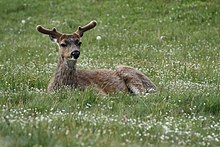Black-tailed deer: Difference between revisions
| Line 56: | Line 56: | ||
[[de:Maultierhirsch]] |
[[de:Maultierhirsch]] |
||
[[it:Odocoileus hemionus columbianus]] |
[[it:Odocoileus hemionus columbianus]] |
||
iguasdo fiassdhg weiner |
|||
Revision as of 18:18, 24 April 2009
| Black-tailed deer | |
|---|---|

| |
| Male, Yosemite National Park | |
| Scientific classification | |
| Kingdom: | |
| Phylum: | |
| Class: | |
| Order: | |
| Suborder: | |
| Family: | |
| Subfamily: | |
| Genus: | |
| Species: | |
| Subspecies: | O. h. columbianus
|
| Trinomial name | |
| Odocoileus hemionus columbianus Richardson, 1829
| |




The Black-tailed deer, or Blacktail deer, (Odocoileus hemionus) is a species of deer found in western North America, specifically the Pacific Northwest region.
Black-tailed deer once ranged at least as far as Wyoming. In Francis Parkman's The Oregon Trail, an eyewitness account of his 1846 trek across the early West, while within a two-days ride from Fort Laramie, Parkman writes of shooting what he believes to be an elk, only to discover that he has killed a Black-tailed Deer.[1]
It is sometimes classified as a subspecies of the mule deer, as reflected in its scientific name Odocoileus hemionus columbianus as compared to the Rocky Mountain mule deer's Odocoileus hemionus hemionus. However this classification is not widely followed. It is more closely related to the Sitka deer.
The Black-tailed deer is currently common in northern California, western Oregon, Washington, coastal British Columbia, and north into the Alaskan panhandle. There remains confusion, however, over its proper classification. It is a popular game animal.
Ecology
This species thrives on the edge of the forest, as the dark forest lacks the underbrush and grasslands that the deer prefers as food, and completely open areas lack the hiding spots and the cover it prefers for harsh weather. One of the plants that Black tailed deer browse is Western poison oak, in spite of this plant's content of toxins.[2] This deer often is most active at dawn and dusk, and is frequently involved in collisions with automobiles.
See also
Line note references
black tail xsde46ynytkl/hhh6.urjwelf stubby
External links
![]() Media related to Odocoileus hemionus columbianus at Wikimedia Commons
Media related to Odocoileus hemionus columbianus at Wikimedia Commons
iguasdo fiassdhg weiner
